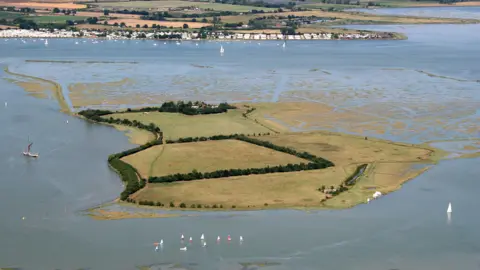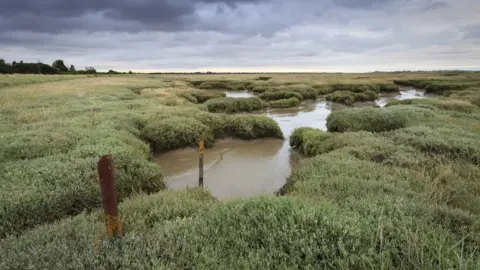Part of sea wall removed to help Northey Island saltmarsh
 Terry Joyce
Terry JoyceSome sea wall has been taken down to stop a saltmarsh being eroded in Essex.
Conservationists said opening up more space for seawater to come through at Northey Island would slow down a phenomenon called "coastal squeeze", which deteriorates habitats.
The saltmarsh, in the Blackwater Estuary, would have disappeared in the next 100 years if nothing was done, the National Trust said.
"You're now giving more space for nature to operate," said a spokesman.
Daniel Leggett, senior coastal project manager for the charity, said: "Under sea-level rise and climate change at the location we're talking about, if we do nothing, then in 100 years' time all the saltmarsh is gone."It [saltmarsh] sequesters carbon, it's important for fish nursery areas, birds of course use it and the vegetation and the landscape itself."
 National Trust/PA Media
National Trust/PA MediaAbout 250 metres (820ft) of wall has been removed, allowing high tides through to deposit seeds and sediment and create new saltmarsh.
Mr Leggett said: "If you're within an estuarine location, which this is, if you keep all the sea walls where they are and keep building them higher, all you're doing is funnelling the tidal energy into an ever-decreasing area.
"It's getting faster and faster, getting deeper, and if it's deeper it will also have bigger waves."
He said this would lead to loss of habitat.
 National Trust/PA Media
National Trust/PA Media"This is a process that's commonly referred to as 'coastal squeeze'."You've got the man-made defence, the rising sea level and the habitat in-between is getting squeezed out of existence."By taking the sea wall down, what you're doing is allowing what nature would do, which as sea levels rise it would spread sideways into the floodplain - and that slows things down and reduces energy."You're now giving more space for nature to operate within."
 National Trust/PA Media
National Trust/PA Media
Follow East of England news on Facebook, Instagram and X. Got a story? Email [email protected] or WhatsApp 0800 169 1830
